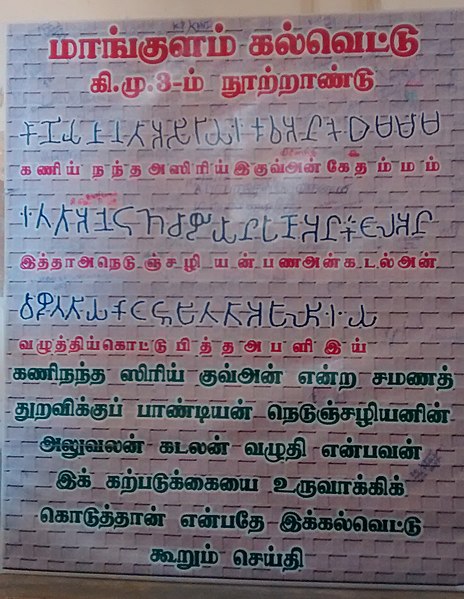The Grantha script was a classical South Indian Brahmic script, found particularly in Tamil Nadu and Kerala. Originating from the Pallava script, the Grantha script is related to Tamil and Vatteluttu scripts. The modern Malayalam script of Kerala is a direct descendant of the Grantha script. The Southeast Asian and Indonesian scripts such as Thai and Javanese respectively, as well as South Asian Tigalari and Sinhala scripts, are derived or closely related to Grantha through the early Pallava script. The Pallava script or Pallava Grantha, emerged in the 4th century CE and was used until the 7th century CE, in India. This early Grantha script was used to write Sanskrit texts, inscriptions on copper plates and stones of Hindu temples and monasteries. It was also used for classical Manipravalam – a language that is a blend of Sanskrit and Tamil. From it evolved Middle Grantha by the 7th century, and Transitional Grantha by about the 8th century, which remained in use until about the 14th century. Modern Grantha has been in use since the 14th century and into the modern era, to write classical texts in Sanskrit and Dravidian languages. It is also used to chant hymns and in traditional Vedic schools.

7th-century inscription in Grantha script at the Mandagapattu Hindu temple
A Chera era Grantha inscription.
8th century Velvikudi grant inscription in the Grantha script (Sanskrit language).
Pratyāhāra Sūtras in Grantha Script
Tamil is a Dravidian language natively spoken by the Tamil people of South Asia. Tamil is an official language of the Indian state of Tamil Nadu and union territory of Puducherry, and the sovereign nations of Sri Lanka and Singapore. Tamil is also spoken by significant minorities in the four other South Indian states of Kerala, Karnataka, Andhra Pradesh and Telangana, and the Union Territory of the Andaman and Nicobar Islands. It is also spoken by the Tamil diaspora found in many countries, including Malaysia, Myanmar, South Africa, United Kingdom, United States, Canada, Australia, New Zealand, United Arab Emirates, Saudi Arabia, France, Germany, Italy, Indonesia, and Mauritius. Tamil is also natively spoken by the Sri Lankan Moors. One of 22 scheduled languages in the Constitution of India, Tamil was the first to be classified as a classical language of India.
Findings from Adichanallur in the Government Museum, Chennai
Keezhadi excavation site
Explanation for Mangulam Tamil Brahmi inscription in Mangulam, Madurai district, Tamil Nadu, dated to Tamil Sangam period (c. 400 BC – c. 200 AD)
Tamil Brahmi script in the reverse side of the bilingual silver coin of king Vashishtiputra Sātakarni (c. AD 160) of Deccan. Rev: Ujjain/Sātavāhana symbol, crescented six-arch chaitya hill and river with Tamil Brahmi script Obv: Bust of king; Prakrit legend in the Brahmi script








